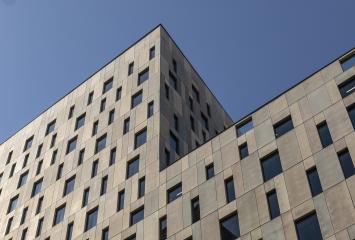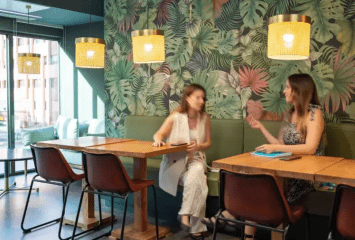Circular structuring as an option to achieve well-being at work
The circular structuring of offices consists of a workspace design where different rooms and workstations are arranged in a ring pattern around a central point. Unlike what happens in the classic office design, dominant for many decades, with circular structuring, open offices are generated without defined physical barriers in which access to different rooms or workstations is easy and without following any hierarchical organization. In that sense, it is a spatial configuration much more in line with the horizontal spirit of the contemporary company.
But its benefits are not limited to the professional performance sphere. Circular structuring also offers facilities for companies to carry out sustainable and planet-friendly operations. Specifically, it promotes maximization of access to natural light and air currents that ventilate the space naturally without the need for technologies that consume energy. All of these reasons have contributed to the exponential increase in the popularity of circular structuring in recent years and its growing implementation in more and more office buildings.
More satisfied workers
Both the company's performance and environmental protection are highly sought-after benefits by modern companies. But the satisfaction of their workers is also essential. Circular structuring also has the capacity to promote it. More specifically, this way of arranging work elements in an office improves communication between people, fosters both creative and stress-relieving interaction, provides them with a very gratifying flexibility that fulfills their desires for freedom of movement and decision-making, and ultimately enhances the work environment. Total isolation is almost always undesirable.
Moreover, and very importantly, non-linear structuring contributes to the construction of a more inclusive environment. After all, it largely eliminates the physical barriers that separate people and reduces distances so that everything, regardless of its nature and hierarchy within the organization, is much more accessible. The combination of this type of design with inclusive furniture and attention to mobility elements results in an office that embraces everyone regardless of their physical abilities. This has great moral value in itself, but also, as a collateral benefit, great reputational value.
Torre Marenostrum: our example of circular structuring
Torre Marenostrum, located on the seafront of Barcelona, facing the Mediterranean Sea, is one of the most prominent office buildings in the city for several reasons: its unique architectural exterior, its disconnection from energy from fossil sources, its immersion in the nature of the sea thanks to privileged views and the sound of the waves, its more than 22,000 square meters of rentable office space, or the presence of open environments of Utopicus in its facilities. However, there is one more reason that is often overlooked: its internal circular structuring. No borders. No hierarchies. No rigidities.
A layout that, as we have seen throughout this article, makes a big difference in the soul of a company, in the quality of individual and collective work, and in the well-being of employees. And not only that: this design, which allows desks to be placed in a ring around a very large common space, also provides a qualitative leap to the image projected by the company to its clients and potential talents to hire. In any case, and as we often point out, each organization is unique and can benefit more from some design decisions than others. We must remember: customization is decisive.

